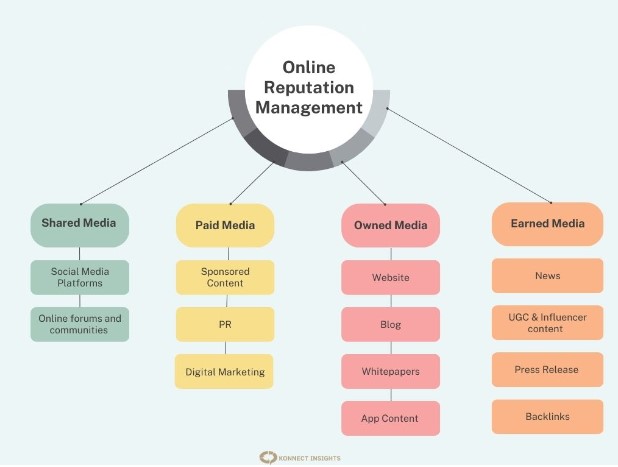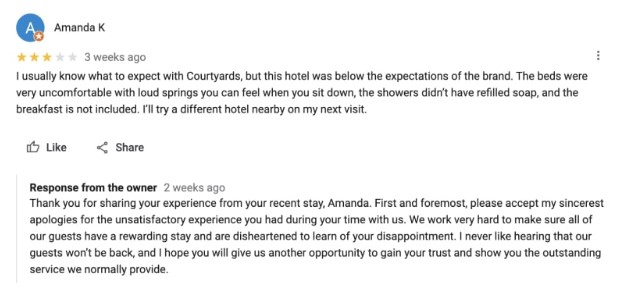Online reputation management (ORM) manages and maintains the public perception of a brand, business, or person online. ORM includes monitoring brand mentions, posting positive reviews, planting PR, sharing social proof, and responding to negative comments.
It comprises basic white-hat self-promotion of a brand and its core values to build an enduring and persuasive reputation.
Do you know the four types of online reputation management?
 Online reputation management is specific to the online world, although the need for it mostly arises due to events and activities unfolding in the offline world. After all, the offline and online lines are quickly blurring.
As digital dependency and e-commerce expand, businesses need a strong and reliable online reputation strategy as a marketing tool.
Don’t miss out on the four hottest online reputation management trends in 2023.
In this blog, we’ll uncover the best online reputation management strategies. Let’s jump right in!
Online reputation management is specific to the online world, although the need for it mostly arises due to events and activities unfolding in the offline world. After all, the offline and online lines are quickly blurring.
As digital dependency and e-commerce expand, businesses need a strong and reliable online reputation strategy as a marketing tool.
Don’t miss out on the four hottest online reputation management trends in 2023.
In this blog, we’ll uncover the best online reputation management strategies. Let’s jump right in!
 Taking negative reviews in stride is one of the benchmarks of a professionally devised online reputation management strategy.
Taking negative reviews in stride is one of the benchmarks of a professionally devised online reputation management strategy.
Online reputation management in digital marketing
Online reputation management in digital marketing is exactly as it sounds. To expand, ORM in digital marketing comprises the strategic and perpetual process of building a brand image through paid, earned, shared, and owned media. Online reputation management is specific to the online world, although the need for it mostly arises due to events and activities unfolding in the offline world. After all, the offline and online lines are quickly blurring.
As digital dependency and e-commerce expand, businesses need a strong and reliable online reputation strategy as a marketing tool.
Don’t miss out on the four hottest online reputation management trends in 2023.
In this blog, we’ll uncover the best online reputation management strategies. Let’s jump right in!
Online reputation management is specific to the online world, although the need for it mostly arises due to events and activities unfolding in the offline world. After all, the offline and online lines are quickly blurring.
As digital dependency and e-commerce expand, businesses need a strong and reliable online reputation strategy as a marketing tool.
Don’t miss out on the four hottest online reputation management trends in 2023.
In this blog, we’ll uncover the best online reputation management strategies. Let’s jump right in!
7 steps to online reputation management
There are ample reasons why your business needs a robust online reputation management plan in place at all times. The Internet is wildfire, and it doesn’t take much to turn your decades of reputation to dust. Before getting started, read the 7 Essential elements of online reputation management. Here are seven key steps that you can take to implement an effective ORM in your business:1. Monitor your reputation.
So the first step in the process is monitoring our brand’s reputation, essentially tracking how people talk about your business and its products and services online. The trickiest part of building an online brand is that you don’t just have to monitor what your target audience says about you. Often, the most passionate commentators will never buy from you. This means you need to monitor how your business is viewed by the entire world, not just your target group. Here are some ways you can monitor your reputation online:- Scan through your social media platforms: Scan through your social media platforms like Facebook, Instagram, TikTok, etc., and go through your mentions. Read the comments, analyze the shares, and thoroughly search your brand’s name on the general search bar.
- Analyze your website: Your website metrics give you an insight into the bounce rate, page views, time on site, and many other crucial things you must keep in mind. You can track them to understand how visitors see your brand online.
- Set up Google Alerts: Use the free Google Alerts tool and get notified whenever your brand is mentioned on the web. You can also tweak the search results and set alerts for the names of key personnel, best-selling products, and relevant keywords.
- Track social reviews: Monitor ratings and reviews on your product or service’s main selling page and other supplementary sites such as Google Play, Amazon, and Yelp. Take stock of what your customers say about the brand.
- Use professional online reputation management services: As your business scales, you can no longer track every mention and review by hand. You will need systems, various online reputation tools, and online reputation management companies to handle the operations.
2. Decide how you want your audience to see you.
When it comes to building and safeguarding your online reputation, you need to have a proactive strategy. Instead of letting the masses define your business, you must get ahead of the crowd and create your brand story. There are five brand personas:- Sincerity: down-to-earth, cheerful, and wholesome (Eg. Patagonia)
- Excitement: daring, up-to-date, and imaginative (e.g., Red Bull)
- Competence: successful, intelligent, and industry leader (e.g., BMW)
- Sophistication: Charming, luxurious, and aspirational (e.g., Balmain)
- Ruggedness: Tough, masculine, and outdoorsy (e.g., Harley Davidson)
3. Evaluate your current online reputation.
The next step in the process is understanding how your brand is perceived right now.- What is your current brand persona?
- Are you a leader in your niche?
- How do your customers see you?
- What are your customers saying about you?
4. Create a social media content strategy.
Social media is an integral part of your online reputation management and is one of the few strategies you can exert 100% control over. You need a coherent, cohesive, and sustainable social media content strategy for all channels. This begins with:- Identifying your brand story and charting specific social media goals (e.g., followers, subscriptions, etc.)
- Picking at least two platforms of focus
- Doing competitive studies
- Optimizing social media posting strategies
- Innovating and adapting to new trends
 Taking negative reviews in stride is one of the benchmarks of a professionally devised online reputation management strategy.
Taking negative reviews in stride is one of the benchmarks of a professionally devised online reputation management strategy.
5. Post-quality content
“In for a penny, in for a pound!” Creating quality content aligned with your strategy is hard and takes considerable investment. Thankfully, it pays off in due time. Quality content values your readership, improves online visibility, and cements your brand as the authority in your niche. SEO-driven blogs, active communities, and forums support the right content marketing strategy.6. Engage with your audience.
The next step is developing an empathic and value-driven relationship with your audience. Reply to their comments, address their concerns, and devise a response plan to negative feedback. Your response plan should be empathetic and meaningful. Instead of hiding the comment or countering the objection, you should have a professional response that makes your customer feel seen and heard. Having customer service representatives and community managers address the concerns head-on lowers the chance of getting negative reviews by 90%. Engaging with the audience also encourages customers to offer feedback and leave reviews about their experience.7. Follow through and measure your results.
Now that you have an online reputation management strategy, it is time to step back, follow through, and measure the results. You can gauge these results by asking yourself these questions:- Is there a change or improvement in your brand perception?
- Is there an improvement in your engagement rate?
- Do you have a different brand story that stands out in your marketing campaigns?

